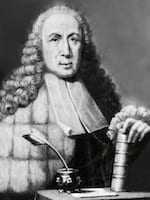Giovanni Battista Morgagni

Giovanni Battista Morgagni (1682 – 1771) was an Italian physician, anatomist and pathologist.
Morgagni often described as the ‘father of anatomic pathology’. He correlated postmortem pathology and clinical findings and was known for his exactitude and precision, in both his dissections and his writing. He determined that diagnosis, prognosis, and treatment of disease must be based on an exact understanding of pathological changes in anatomical structures
He believed in contagion and would not dissect patients with tuberculosis or smallpox. Virchow considered that Morgagni introduced modern pathology – ‘with him begins modern medicine‘
Biography
- Born 25 February 1682 Forli, Italy
- University of Bologna, Pupil of Valsalva
- Died 5 December 1771
Medical Eponyms
Morgagni hernia
Congenital diaphragmatic hernia. Characterised by herniation through the foramen of Morgagni. In comparison to Bochdalek hernia, they are more anterior and more often right-sided (~90%)
Key Medical Attributions
Morgagni provided multiple early descriptions of eponymous diseases
- Morgagni proved Valsalva’s contention that the cerebral lesion in stroke causing paralysis is on the opposite side of the brain.
- Described Fallot’s tetralogy, aortic coarctation; pneumonia with consolidation
- One of the earliest description of Crohn disease in 1761
Morgagni described Stokes-Adams attacks in at least 2 sections of De sedibus, et causis morborum per anatomen indagatis from 1761
Firstly in De Morbis Capitis (letter IX, article 7); he details the case of the priest Anastasio Poggi
…fellow-citizen Anastasio Poggi, a grave and worthy priest. He was in his sixty-eighth year, of a habit moderately fat, and of a florid complexion, when he he was first seized with the epilepsy, which left behind it the greatest slowness of pulse, and in like manner a coldness of the body.
Morgagni 1761; IX(8): 192
Morgagni refers to the 1717 publication by Slovenian physician Marcus Gerbezius (1658-1718)
But, perhaps, you will suspect, whether the rarity of the pulse be, in fact, a very uncommon symptom, to remain after an epilepsy, in hypochondriac patients, when you shall have compar’d this observation of mine with that of the celebrated Gerbezius (t), which describes the pulse of a strong hypochondriac man, “who was now and then subject to slight epileptic ‘paroxysms’, even when he was in health”, as being “so very slow, that before the subsequent pulsation follow’d that which went before, three pulsations would certainly have pass’d in another healthy person.”
Morgagni 1761; IX(8): 195
Then in De morbis thoracis (letter LXIV, article 5) regarding the case of a 64 year old merchant from Padua, a full-bodied man, who collapsed following vertigo
When visiting by way of consultation, I found with such a rarity of the pulse that within the 60th part of an hour the pulsations were only 22 – and this rareness which was perpetual – was perceived to be even more considerable, as often as even two (epileptic) attacks were at hand – so that the physicians were never deceived from the increase of the rareness they foretold a paroxysm to be coming on.
Morgagni 1761; LXIV(5): 505
Death occurred 15 months after the onset of the symptoms. At autopsy, Morgagni observed that the heart was dilated because of the enlargement of ventricles; the aorta was dilated in the same way from the beginning of its curve
Cor vero amplum valde ob dilatatos ventriculos, non ob parietes factos crassiores. Magna etiam arteria ad curvatura; usque initium aequo latior…spirituum et nervorum vitium
Morgagni 1761; LXIV(5): 507
Morgagni remarked that the slow pulse rate could not be connected to aneurisms of the heart and aorta and that the disease had been produced by a disorder of the nerves (“spirituum et nervorum vitium”).
Major Publications
- Morgagni GB. Adversaria anatomica: Prima; Tertia; Quarta; Quinta; Sexta. [Omnia; Altera]. 1719
- Morgagni GB. De sedibus, et causis morborum per anatomen indagatis. 1761 Tomus II; Tomus III
- Morgagni GB. The seats and causes of diseases investigated by anatomy (3 volumes: Translation by Benjamin Alexander) 1769. Vol II, Vol III
- Morgagni GB. The seats and causes of diseases, investigated by anatomy (2 Volumes: translation by William Cooke) 1882 Vol II
References
Biography
- Flaxman N. The history of heart-block. Bulletin of the Institute of the History of Medicine. 1937; 5(2): 115-130
- Zani A, Cozzi DA. Giovanni Battista Morgagni and his contribution to pediatric surgery. Journal of Pediatric Surgery, 2008; 43(4): 729–733
- Bibliography. Morgagni, Giambattista 1682-1771. WorldCat Identities
Eponymous terms
- Slavec ZZ, Neudauer U. Marcus Gerbezius (1658–1718) and his first description of a complete atrioventricular block. Zdravniški vestnik 2015; 84(12): 855-860
- Lippi D. Gerbezius’ Pulsus Mira Inconstantia and the First Descriptions of the Atrioventricular Block. Cardiac Electrophysiology Clinics, 2018; 10(2): 179–1821
- Buttner R, Lee J. De-eponymising anatomical terminology. 2020
Eponym
the person behind the name
